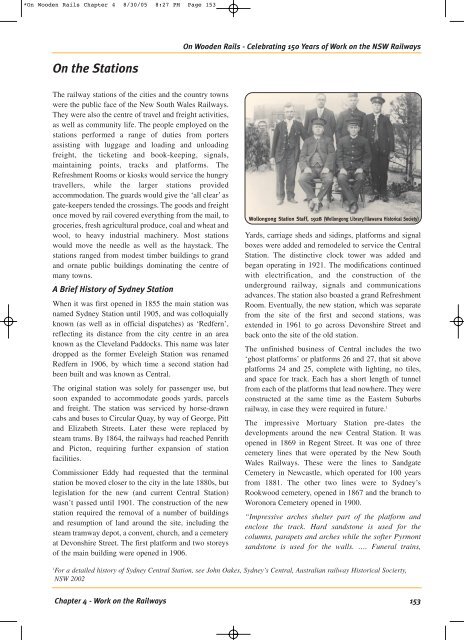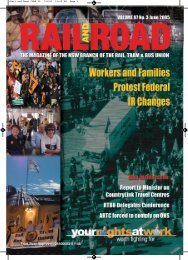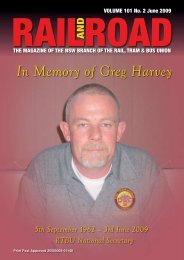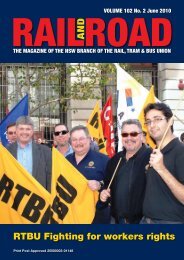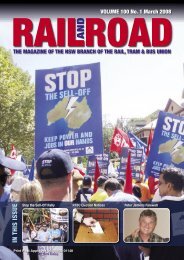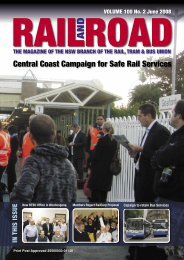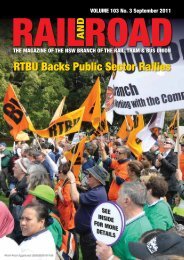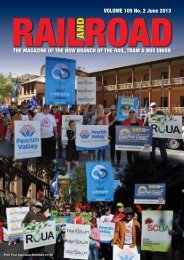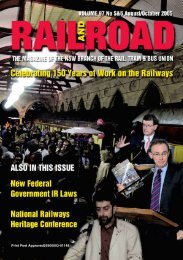Chapter 4 - Work on the Railways - Rail, Tram and Bus Union of NSW
Chapter 4 - Work on the Railways - Rail, Tram and Bus Union of NSW
Chapter 4 - Work on the Railways - Rail, Tram and Bus Union of NSW
You also want an ePaper? Increase the reach of your titles
YUMPU automatically turns print PDFs into web optimized ePapers that Google loves.
*On Wooden <strong>Rail</strong>s <str<strong>on</strong>g>Chapter</str<strong>on</strong>g> 4 8/30/05 8:27 PM Page 153<br />
On <strong>the</strong> Stati<strong>on</strong>s<br />
The railway stati<strong>on</strong>s <strong>of</strong> <strong>the</strong> cities <strong>and</strong> <strong>the</strong> country towns<br />
were <strong>the</strong> public face <strong>of</strong> <strong>the</strong> New South Wales <strong><strong>Rail</strong>ways</strong>.<br />
They were also <strong>the</strong> centre <strong>of</strong> travel <strong>and</strong> freight activities,<br />
as well as community life. The people employed <strong>on</strong> <strong>the</strong><br />
stati<strong>on</strong>s performed a range <strong>of</strong> duties from porters<br />
assisting with luggage <strong>and</strong> loading <strong>and</strong> unloading<br />
freight, <strong>the</strong> ticketing <strong>and</strong> book-keeping, signals,<br />
maintaining points, tracks <strong>and</strong> platforms. The<br />
Refreshment Rooms or kiosks would service <strong>the</strong> hungry<br />
travellers, while <strong>the</strong> larger stati<strong>on</strong>s provided<br />
accommodati<strong>on</strong>. The guards would give <strong>the</strong> ‘all clear’ as<br />
gate-keepers tended <strong>the</strong> crossings. The goods <strong>and</strong> freight<br />
<strong>on</strong>ce moved by rail covered everything from <strong>the</strong> mail, to<br />
groceries, fresh agricultural produce, coal <strong>and</strong> wheat <strong>and</strong><br />
wool, to heavy industrial machinery. Most stati<strong>on</strong>s<br />
would move <strong>the</strong> needle as well as <strong>the</strong> haystack. The<br />
stati<strong>on</strong>s ranged from modest timber buildings to gr<strong>and</strong><br />
<strong>and</strong> ornate public buildings dominating <strong>the</strong> centre <strong>of</strong><br />
many towns.<br />
A Brief History <strong>of</strong> Sydney Stati<strong>on</strong><br />
When it was first opened in 1855 <strong>the</strong> main stati<strong>on</strong> was<br />
named Sydney Stati<strong>on</strong> until 1905, <strong>and</strong> was colloquially<br />
known (as well as in <strong>of</strong>ficial dispatches) as ‘Redfern’,<br />
reflecting its distance from <strong>the</strong> city centre in an area<br />
known as <strong>the</strong> Clevel<strong>and</strong> Paddocks. This name was later<br />
dropped as <strong>the</strong> former Eveleigh Stati<strong>on</strong> was renamed<br />
Redfern in 1906, by which time a sec<strong>on</strong>d stati<strong>on</strong> had<br />
been built <strong>and</strong> was known as Central.<br />
The original stati<strong>on</strong> was solely for passenger use, but<br />
so<strong>on</strong> exp<strong>and</strong>ed to accommodate goods yards, parcels<br />
<strong>and</strong> freight. The stati<strong>on</strong> was serviced by horse-drawn<br />
cabs <strong>and</strong> buses to Circular Quay, by way <strong>of</strong> George, Pitt<br />
<strong>and</strong> Elizabeth Streets. Later <strong>the</strong>se were replaced by<br />
steam trams. By 1864, <strong>the</strong> railways had reached Penrith<br />
<strong>and</strong> Pict<strong>on</strong>, requiring fur<strong>the</strong>r expansi<strong>on</strong> <strong>of</strong> stati<strong>on</strong><br />
facilities.<br />
Commissi<strong>on</strong>er Eddy had requested that <strong>the</strong> terminal<br />
stati<strong>on</strong> be moved closer to <strong>the</strong> city in <strong>the</strong> late 1880s, but<br />
legislati<strong>on</strong> for <strong>the</strong> new (<strong>and</strong> current Central Stati<strong>on</strong>)<br />
wasn’t passed until 1901. The c<strong>on</strong>structi<strong>on</strong> <strong>of</strong> <strong>the</strong> new<br />
stati<strong>on</strong> required <strong>the</strong> removal <strong>of</strong> a number <strong>of</strong> buildings<br />
<strong>and</strong> resumpti<strong>on</strong> <strong>of</strong> l<strong>and</strong> around <strong>the</strong> site, including <strong>the</strong><br />
steam tramway depot, a c<strong>on</strong>vent, church, <strong>and</strong> a cemetery<br />
at Dev<strong>on</strong>shire Street. The first platform <strong>and</strong> two storeys<br />
<strong>of</strong> <strong>the</strong> main building were opened in 1906.<br />
On Wooden <strong>Rail</strong>s - Celebrating 150 Years <strong>of</strong> <str<strong>on</strong>g>Work</str<strong>on</strong>g> <strong>on</strong> <strong>the</strong> <strong>NSW</strong> <strong><strong>Rail</strong>ways</strong><br />
Woll<strong>on</strong>g<strong>on</strong>g Stati<strong>on</strong> Staff, 1928 (Woll<strong>on</strong>g<strong>on</strong>g Library/Illawarra Historical Society)<br />
Yards, carriage sheds <strong>and</strong> sidings, platforms <strong>and</strong> signal<br />
boxes were added <strong>and</strong> remodeled to service <strong>the</strong> Central<br />
Stati<strong>on</strong>. The distinctive clock tower was added <strong>and</strong><br />
began operating in 1921. The modificati<strong>on</strong>s c<strong>on</strong>tinued<br />
with electrificati<strong>on</strong>, <strong>and</strong> <strong>the</strong> c<strong>on</strong>structi<strong>on</strong> <strong>of</strong> <strong>the</strong><br />
underground railway, signals <strong>and</strong> communicati<strong>on</strong>s<br />
advances. The stati<strong>on</strong> also boasted a gr<strong>and</strong> Refreshment<br />
Room. Eventually, <strong>the</strong> new stati<strong>on</strong>, which was separate<br />
from <strong>the</strong> site <strong>of</strong> <strong>the</strong> first <strong>and</strong> sec<strong>on</strong>d stati<strong>on</strong>s, was<br />
extended in 1961 to go across Dev<strong>on</strong>shire Street <strong>and</strong><br />
back <strong>on</strong>to <strong>the</strong> site <strong>of</strong> <strong>the</strong> old stati<strong>on</strong>.<br />
The unfinished business <strong>of</strong> Central includes <strong>the</strong> two<br />
‘ghost platforms’ or platforms 26 <strong>and</strong> 27, that sit above<br />
platforms 24 <strong>and</strong> 25, complete with lighting, no tiles,<br />
<strong>and</strong> space for track. Each has a short length <strong>of</strong> tunnel<br />
from each <strong>of</strong> <strong>the</strong> platforms that lead nowhere. They were<br />
c<strong>on</strong>structed at <strong>the</strong> same time as <strong>the</strong> Eastern Suburbs<br />
railway, in case <strong>the</strong>y were required in future. 1<br />
The impressive Mortuary Stati<strong>on</strong> pre-dates <strong>the</strong><br />
developments around <strong>the</strong> new Central Stati<strong>on</strong>. It was<br />
opened in 1869 in Regent Street. It was <strong>on</strong>e <strong>of</strong> three<br />
cemetery lines that were operated by <strong>the</strong> New South<br />
Wales <strong><strong>Rail</strong>ways</strong>. These were <strong>the</strong> lines to S<strong>and</strong>gate<br />
Cemetery in Newcastle, which operated for 100 years<br />
from 1881. The o<strong>the</strong>r two lines were to Sydney’s<br />
Rookwood cemetery, opened in 1867 <strong>and</strong> <strong>the</strong> branch to<br />
Wor<strong>on</strong>ora Cemetery opened in 1900.<br />
“Impressive arches shelter part <strong>of</strong> <strong>the</strong> platform <strong>and</strong><br />
enclose <strong>the</strong> track. Hard s<strong>and</strong>st<strong>on</strong>e is used for <strong>the</strong><br />
columns, parapets <strong>and</strong> arches while <strong>the</strong> s<strong>of</strong>ter Pyrm<strong>on</strong>t<br />
s<strong>and</strong>st<strong>on</strong>e is used for <strong>the</strong> walls. …. Funeral trains,<br />
1For a detailed history <strong>of</strong> Sydney Central Stati<strong>on</strong>, see John Oakes, Sydney’s Central, Australian railway Historical Socierty,<br />
<strong>NSW</strong> 2002<br />
<str<strong>on</strong>g>Chapter</str<strong>on</strong>g> 4 - <str<strong>on</strong>g>Work</str<strong>on</strong>g> <strong>on</strong> <strong>the</strong> <strong><strong>Rail</strong>ways</strong> 153


